Developing Sustainable Asphalt Mixtures Using High-Density Polyethylene Plastic Waste Material
Abstract
:1. Introduction
2. Objective and Scope
3. Materials
Preparation of HDPE-Modified Binder
4. Mixture Design
5. Testing Methods
6. Laboratory Test Results and Discussion
6.1. Asphalt Binder Rheological Tests
6.1.1. Superpave Performance Grading (PG)
6.1.2. Multiple Stress Creep Recovery (MSCR)
6.2. Asphalt Mixture Mechanical Tests
6.2.1. Stiffness
6.2.2. Permanent Deformation
6.2.3. Moisture Damage
6.2.4. Fracture and Fatigue Resistance
6.2.5. Durability
6.2.6. Low-Temperature Cracking
7. Field Performance Prediction
8. Conclusions
- Asphalt binder modified with HDPE PWM graded as PG 70-22 exhibited similar rheological properties as SBS-modified PG 70-22 asphalt binder.
- Asphalt mixture M673H containing HDPE PWM achieved higher stiffness than conventional mixtures M76 and M70. For permanent deformation, M673H achieved comparable rutting resistance to the conventional mixtures (M70 and M76) and complied with the threshold of maximum 6 mm specified by LaDOTD for level 2 traffic (ESALs > 3 million). Incorporating HDPE PWM to mixture M673H resulted in further moisture resistance improvement as compared to mixtures M70 and M76.
- Asphalt mixture M673H that contains HDPE PWM possessed a comparable crack resistance Jc parameter as compared to M70 and marginal as compared to M76.
- According to the predicted long-term field cracking performance results obtained from AASHTOWare Pavement ME software (v.1.1.6), the pavement structure containing the wearing course layer of M673H showed statistically similar cracking resistance as the one in pavement structure containing M70.
Author Contributions
Funding
Acknowledgments
Conflicts of Interest
References
- United States Environmental Protection Agency. Plastics: Material-Specific Data. Available online: https://www.epa.gov/facts-and-figures-about-materials-waste-and-recycling/plastics-material-specific-data (accessed on 1 February 2023).
- Chin, C.; Damen, P. Viability of Using Recycled Plastics in Asphalt and Sprayed Sealing Applications; ARRB Group Limited: Victoria, Australia, 2019. [Google Scholar]
- Chen, Y.; Cui, Z.; Cui, X.; Liu, W.; Wang, X.; Li, X.; Li, S. Life cycle assessment of end-of-life treatments of waste plastics in China. Resour. Conserv. Recycl. 2019, 146, 348–357. [Google Scholar] [CrossRef]
- Xu, F.; Zhao, Y.; Li, K. Using waste plastics as asphalt modifier: A review. Materials 2021, 15, 110. [Google Scholar] [CrossRef] [PubMed]
- Leal Filho, W.; Saari, U.; Fedoruk, M.; Iital, A.; Moora, H.; Klöga, M.; Voronova, V. An overview of the problems posed by plastic products and the role of extended producer responsibility in Europe. J. Clean. Prod. 2019, 214, 550–558. [Google Scholar] [CrossRef]
- Euronews.green. Europe Has a Plastic Problem, Only 30% of Plastic Waste Is Recycled. Available online: https://www.euronews.com/green/2019/12/12/europe-has-a-plastic-problem-only-30-of-plastic-waste-is-recycled#:~:text=Europe%20produces%2060%20million%20tons,management%20differs%20among%20European%20countries. (accessed on 1 February 2023).
- Bahl, S.; Dolma, J.; Singh, J.J.; Sehgal, S. Biodegradation of plastics: A state of the art review. Mater. Today Proc. 2021, 39, 31–34. [Google Scholar] [CrossRef]
- He, P.; Chen, L.; Shao, L.; Zhang, H.; Lü, F. Municipal solid waste (MSW) landfill: A source of microplastics?-Evidence of microplastics in landfill leachate. Water Res. 2019, 159, 38–45. [Google Scholar] [CrossRef]
- Hwang, J.; Choi, D.; Han, S.; Choi, J.; Hong, J. An assessment of the toxicity of polypropylene microplastics in human derived cells. Sci. Total Environ. 2019, 684, 657–669. [Google Scholar] [CrossRef] [PubMed]
- INDEPENDENT. India Bans Imports of Waste Plastic to Tackle Environmental Crisis. Available online: https://www.independent.co.uk/climate-change/news/india-plastic-waste-ban-recycling-uk-china-a8811696.html (accessed on 1 February 2023).
- El-Naga, I.A.; Ragab, M. Benefits of utilization the recycle polyethylene terephthalate waste plastic materials as a modifier to asphalt mixtures. Constr. Build. Mater. 2019, 219, 81–90. [Google Scholar] [CrossRef]
- Wu, S.; Montalvo, L. Repurposing waste plastics into cleaner asphalt pavement materials: A critical literature review. J. Clean. Prod. 2021, 280, 124355. [Google Scholar] [CrossRef]
- Ahmadinia, E.; Zargar, M.; Karim, M.R.; Abdelaziz, M.; Shafigh, P. Using waste plastic bottles as additive for stone mastic asphalt. Mater. Des. 2011, 32, 4844–4849. [Google Scholar] [CrossRef]
- Costa, L.M.; Silva, H.M.; Oliveira, J.R.; Fernandes, S.R. Incorporation of waste plastic in asphalt binders to improve their performance in the pavement. Int. J. Pavement Res. Technol. 2013, 6, 457–464. [Google Scholar]
- Ma, Y.; Zhou, H.; Jiang, X.; Polaczyk, P.; Xiao, R.; Zhang, M.; Huang, B. The utilization of waste plastics in asphalt pavements: A review. Clean. Mater. 2021, 2, 100031. [Google Scholar] [CrossRef]
- Modarres, A.; Hamedi, H. Effect of waste plastic bottles on the stiffness and fatigue properties of modified asphalt mixes. Mater. Des. 2014, 61, 8–15. [Google Scholar] [CrossRef]
- Moghaddam, T.B.; Karim, M.R.; Syammaun, T. Dynamic properties of stone mastic asphalt mixtures containing waste plastic bottles. Constr. Build. Mater. 2012, 34, 236–242. [Google Scholar] [CrossRef] [Green Version]
- Haider, S.; Hafeez, I.; Ullah, R. Sustainable use of waste plastic modifiers to strengthen the adhesion properties of asphalt mixtures. Constr. Build. Mater. 2020, 235, 117496. [Google Scholar] [CrossRef]
- Kakar, M.R.; Mikhailenko, P.; Piao, Z.; Poulikakos, L.D. High and low temperature performance of polyethylene waste plastic modified low noise asphalt mixtures. Constr. Build. Mater. 2022, 348, 128633. [Google Scholar] [CrossRef]
- Yao, L.; Leng, Z.; Lan, J.; Chen, R.; Jiang, J. Environmental and economic assessment of collective recycling waste plastic and reclaimed asphalt pavement into pavement construction: A case study in Hong Kong. J. Clean. Prod. 2022, 336, 130405. [Google Scholar] [CrossRef]
- Punith, V.; Veeraragavan, A. Behavior of reclaimed polyethylene modified asphalt cement for paving purposes. J. Mater. Civ. Eng. 2011, 23, 833–845. [Google Scholar] [CrossRef]
- Viscione, N.; Veropalumbo, R.; Oreto, C.; Biancardo, S.A.; Abbondati, F.; Russo, F. Additional procedures for characterizing the performance of recycled polymer modified asphalt mixtures. Measurement 2022, 187, 110238. [Google Scholar] [CrossRef]
- Hınıslıoğlu, S.; Ağar, E. Use of waste high density polyethylene as bitumen modifier in asphalt concrete mix. Mater. Lett. 2004, 58, 267–271. [Google Scholar] [CrossRef]
- Melbouci, B.; Sadoun, S.; Bilek, A. Study of strengthening of recycled asphalt concrete by plastic aggregates. Int. J. Pavement Res. Technol. 2014, 7, 280. [Google Scholar]
- Costa, L.M.; Silva, H.M.; Peralta, J.; Oliveira, J.R. Using waste polymers as a reliable alternative for asphalt binder modification–Performance and morphological assessment. Constr. Build. Mater. 2019, 198, 237–244. [Google Scholar] [CrossRef]
- Arabani, M.; Pedram, M. Laboratory investigation of rutting and fatigue in glassphalt containing waste plastic bottles. Constr. Build. Mater. 2016, 116, 378–383. [Google Scholar] [CrossRef]
- Louisiana Department of Transportation and Development. Louisiana Standard Specifications for Roads and Bridges; Louisiana Department of Transportation and Development: Baton Rouge, LA, USA, 2016. [Google Scholar]
- ASTM D 7173; Standard Practice for Determining the Separation Tendency of Polymer from Polymer-Modified Asphalt. American Society for Testing and Materials: West Conshohocken, PA, USA, 2020.
- ASTM D 4124; Standard Test Method for Separation of Asphalt into Four Fractions. American Society for Testing and Materials: West Conshohocken, PA, USA, 2018.
- Rahman, S.; Hossain, R.; Wasiuddin, N.; Peters, A. Understanding Phase Separation, Aging Characteristics and SARA Fractions of HDPE, LDPE, and PP Modified Asphalt Binder. In Proceedings of the TRB 101st Annual Meeting, Washington, DC, USA, 9–13 January 2001. [Google Scholar]
- AASHTO R-35; Standard Practice for Superpave Volumetric Design for Hot Mix Asphalt (HMA). American Association of State Highway and Transportation Officials: Washington, DC, USA, 2022.
- AASHTO T-342; Standard Method of Test for Determining Dynamic Modulus of Hot Mix Asphalt (HMA). American Association of State Highway and Transportation Officials: Washington, DC, USA, 2022.
- AASHTO T-324; Standard method of test for Hamburg wheel-track testing of compacted hot mix asphalt (HMA). American Association of State Highway and Transportation Officials: Washington, DC, USA, 2022.
- ASTM D 7870; Standard Practice for Moisture Conditioning Compacted Asphalt Mixture Specimens by Using Hydrostatic Pore Pressure. American Society for Testing and Materials: West Conshohocken, PA, USA, 2020.
- ASTM D 8044; Standard Test Method for Evaluation of Asphalt Mixture Cracking Resistance using the Semi-Circular Bend Test (SCB) at Intermediate Temperatures. American Society for Testing and Materials: West Conshohocken, PA, USA, 2016.
- Tex-245-F; Test Procedure for CANTABRO LOSS. 2021. Available online: https://ftp.dot.state.tx.us/pub/txdot-info/cst/TMS/200-F_series/pdfs/bit245.pdf (accessed on 12 February 2023).
- AASHTO T-322; Standard Method of Test for Determining the Creep Compliance and Strength of Hot Mix Asphalt (HMA) Using the Indirect Tensile Test Device. American Association of State Highway and Transportation Officials: Washington, DC, USA, 2007.
- SAS Institute. Base SAS 9.4 Procedures Guide: Statistical Procedures; SAS Institute: Cary, NC, USA, 2017. [Google Scholar]
- AASHTO M320; Standard Specification for Performance-Graded Asphalt Binder. American Association of State Highway and Transportation Officials: Washington, DC, USA, 2022.
- Baumgardner, G. Delta Tc Binder Specification Parameter; Federal Highway Administration: Washington, DC, USA, 2021. [Google Scholar]
- AASHTO T 350; Standard Method of Test for Multiple Stress Creep Recovery Test of Asphalt Binder Using a Dynamic Shear Rheometer. American Association of State Highway and Transportation Officials: Washington, DC, USA, 2022.
- Doyle, J.D.; Howard, I.L. Characterization of dense-graded asphalt with the Cantabro test. J. Test. Eval. 2016, 44, 77–88. [Google Scholar] [CrossRef]
- Bennert, T.; Maher, A. Forensic study on the cracking of New Jersey’s long-term pavement performance specific pavement study sections. Transp. Res. Rec. 2013, 2371, 74–86. [Google Scholar] [CrossRef]
- Christensen, D. Analysis of creep data from indirect tension test on asphalt concrete. J. Assoc. Asph. Paving Technol. 1998, 67, 458–492. [Google Scholar]
- Elnaml, I.; Mousa, M.; Hassan, M.M.; Idris, I.; Mohammad, L. Development of Cost-Effective High-Modulus Asphalt Concrete Mixtures Using Crumb Rubber and Local Construction Materials in Louisiana. Transp. Res. Rec. 2022, 2676, 274–286. [Google Scholar] [CrossRef]
- Wu, Z.; Xiao, D.X. Development of DARWin-ME Design Guideline for Louisiana Pavement Design; Final Report No. FHWA/LA. 11/551; Louisiana Transportation Research Center: Baton Rouge, LA, USA, 2016. [Google Scholar]
- Elnaml, I.; Liu, J.; Mohammad, L.N.; Cooper, S.B., III; Cooper, S.B., Jr. Use of the Iron Chloride Type of Lewis Acid Catalyst in High Reclaimed Asphalt Pavement Content Asphalt Mixtures. Transp. Res. Rec. 2023. [Google Scholar] [CrossRef]
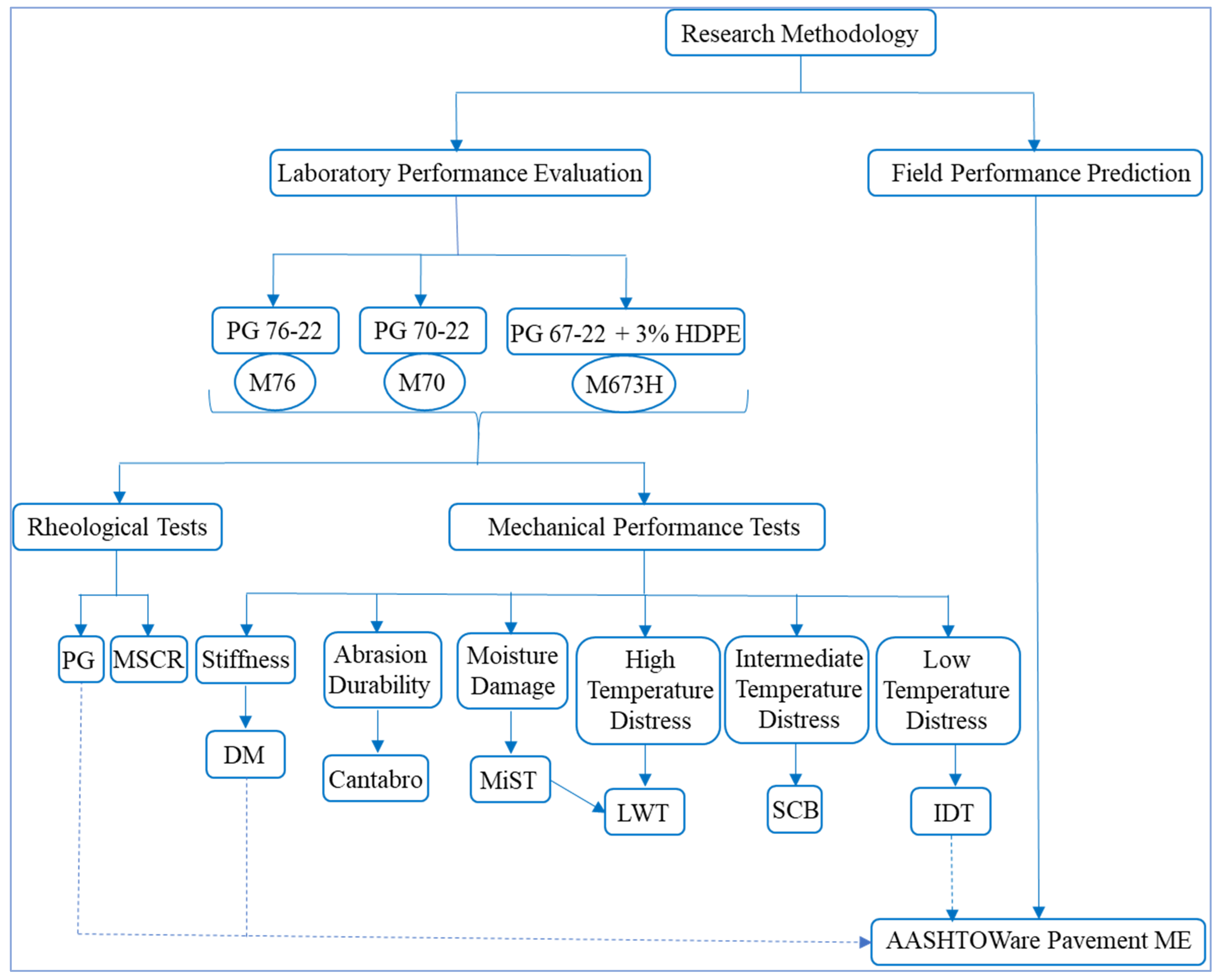
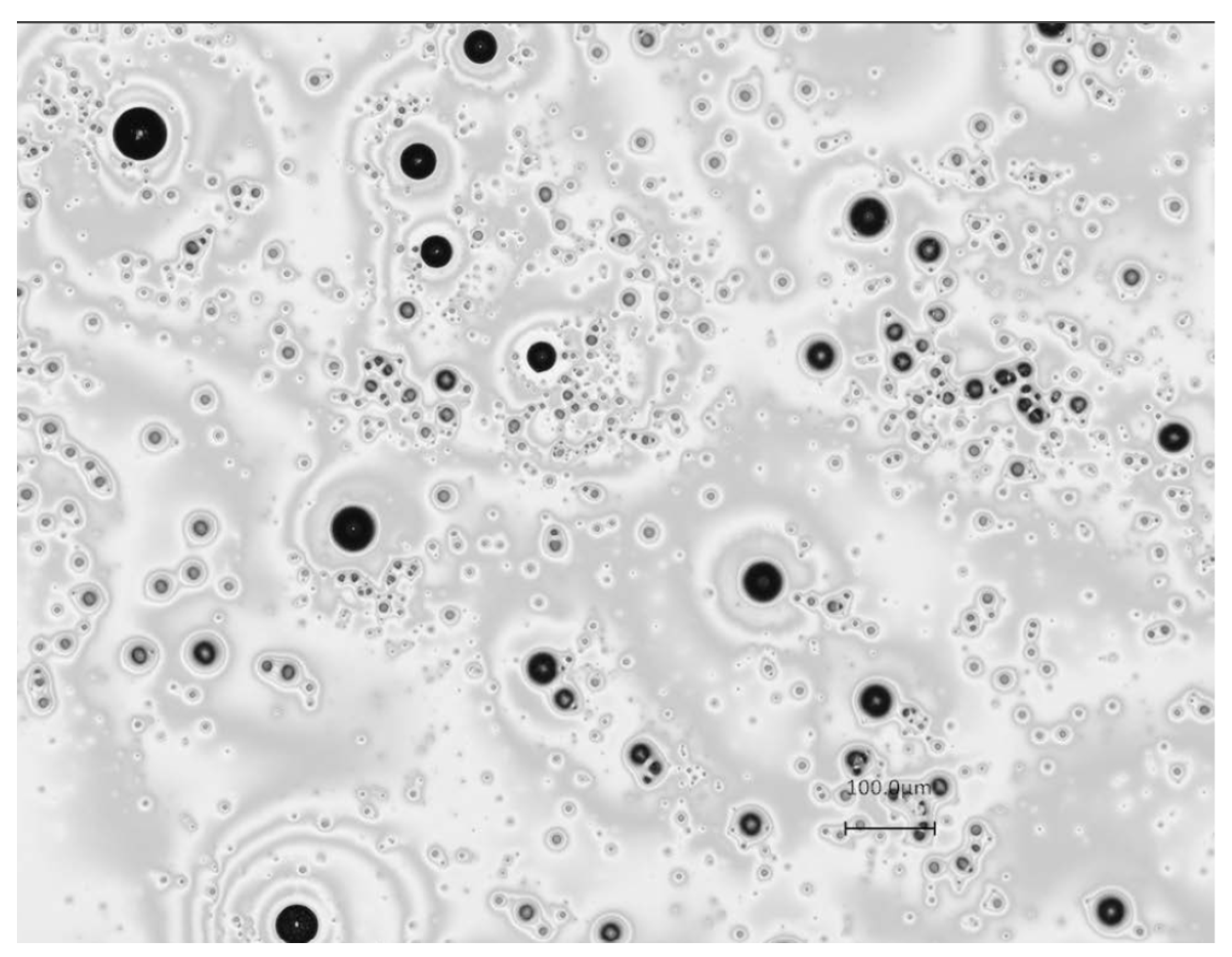
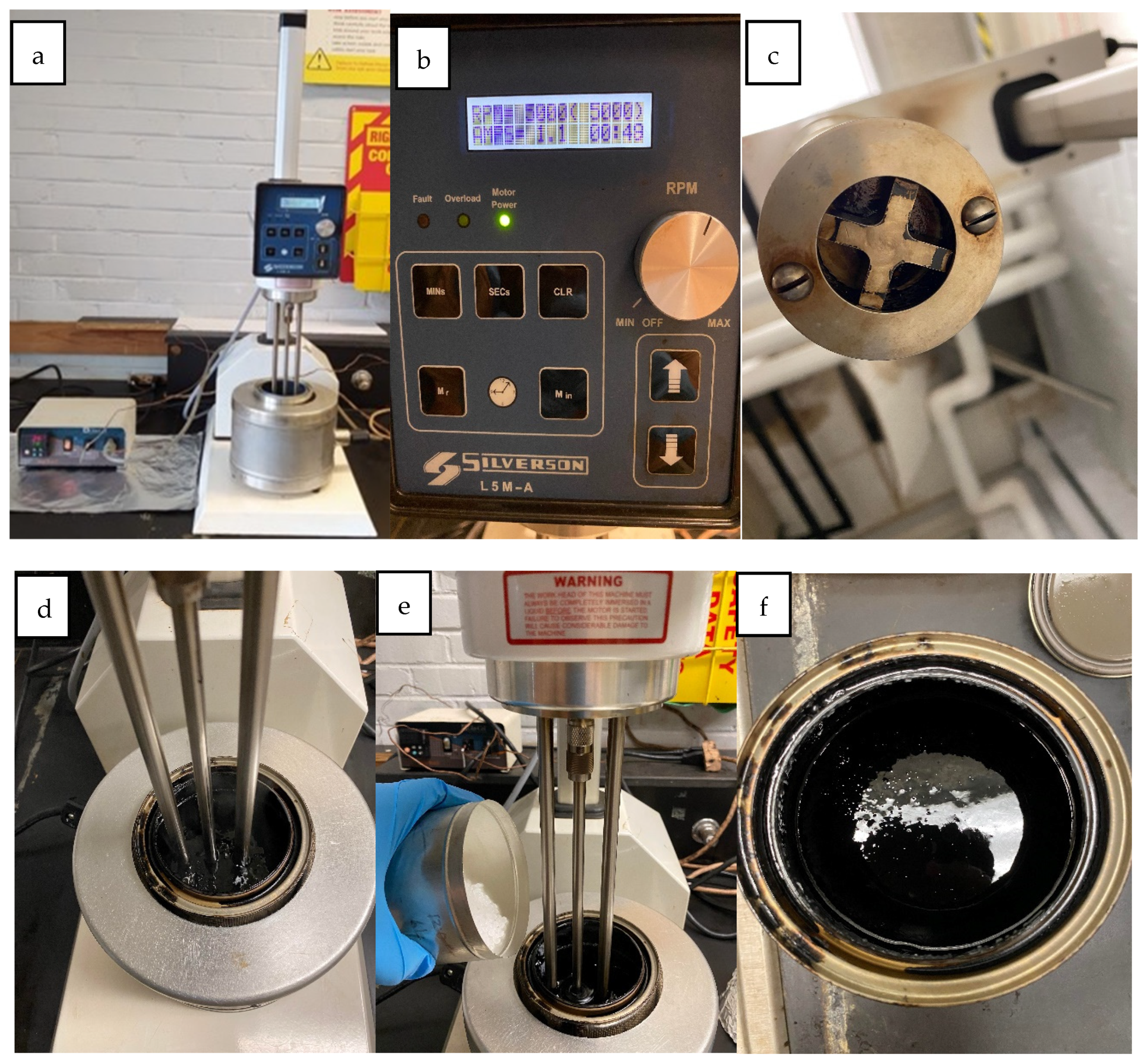
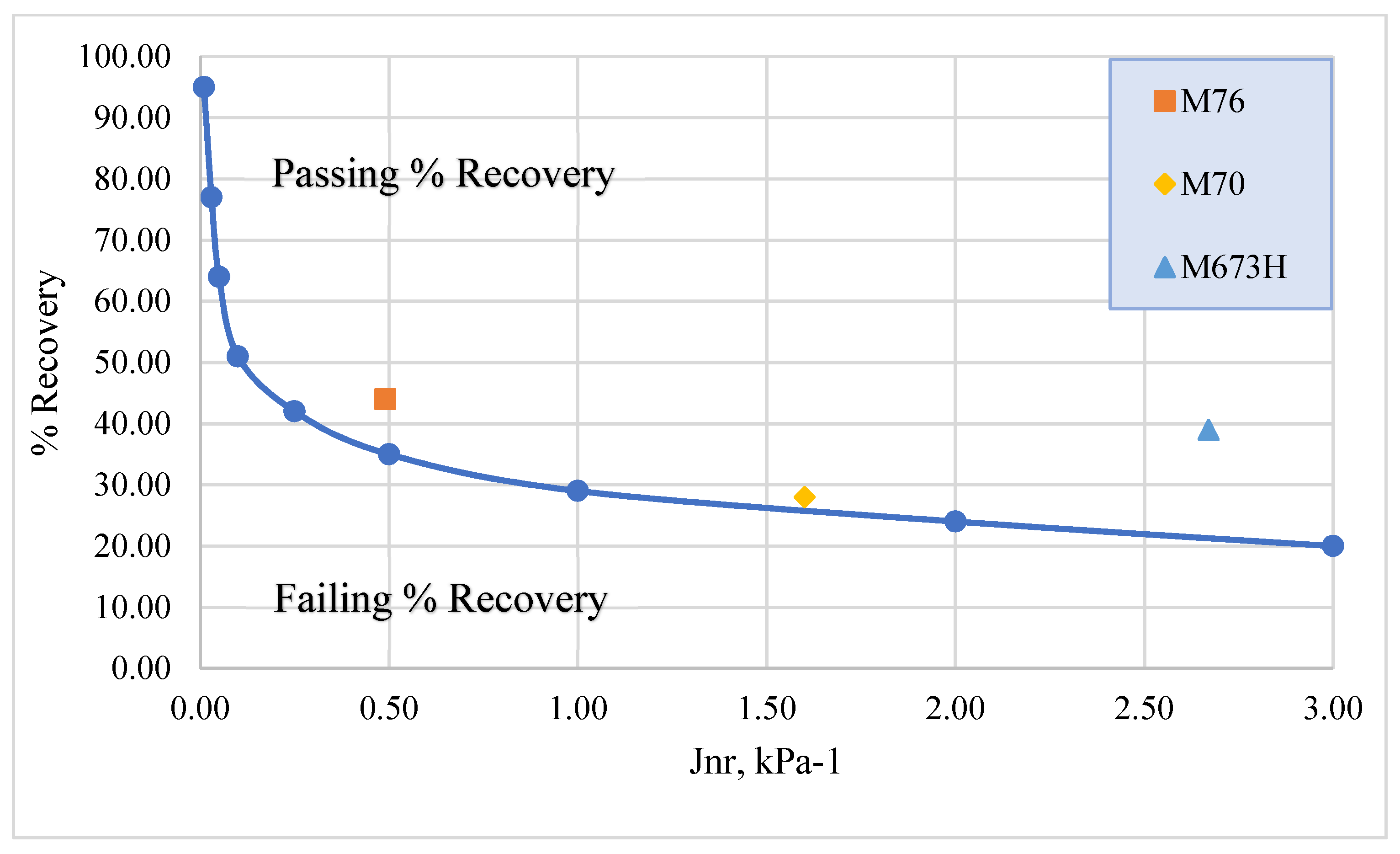
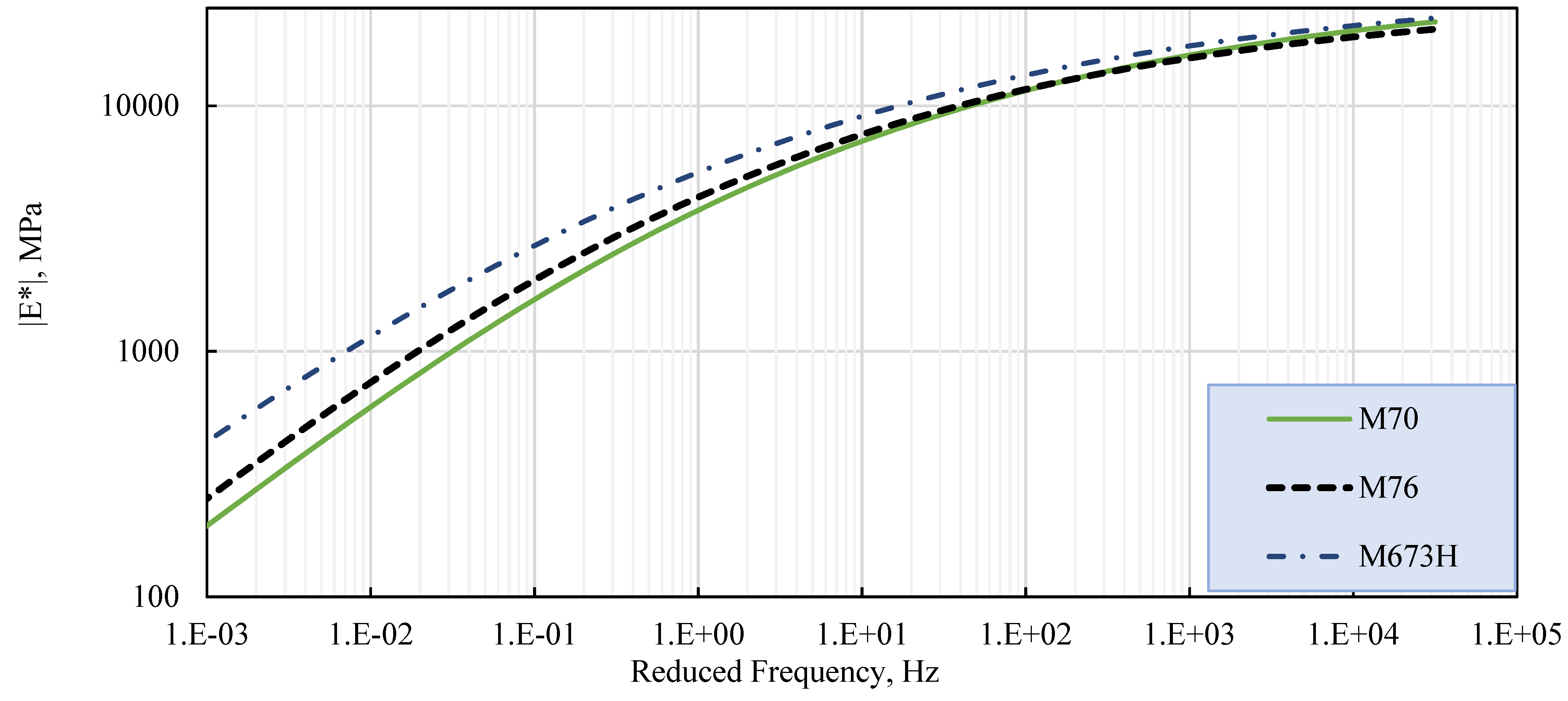


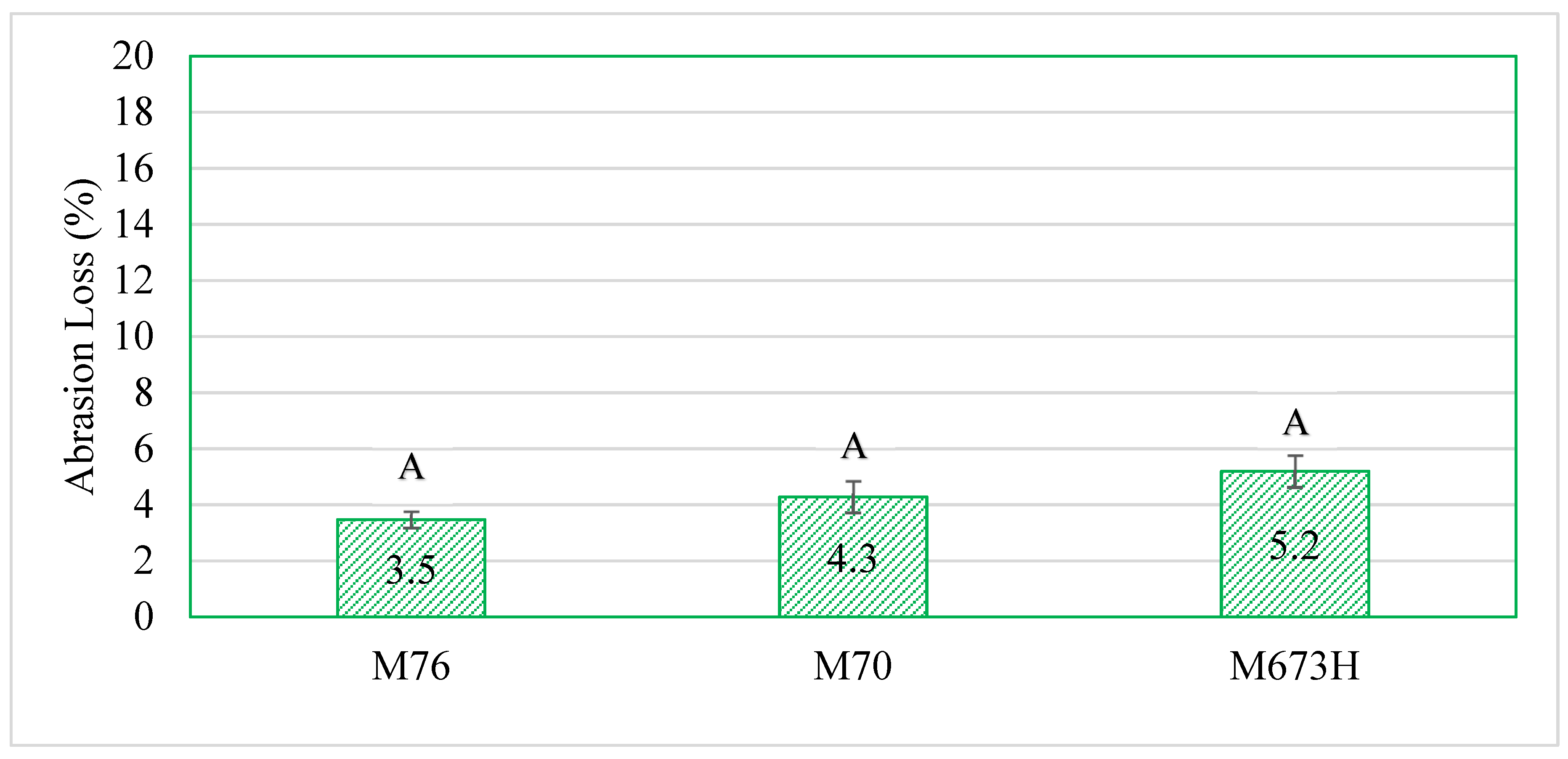

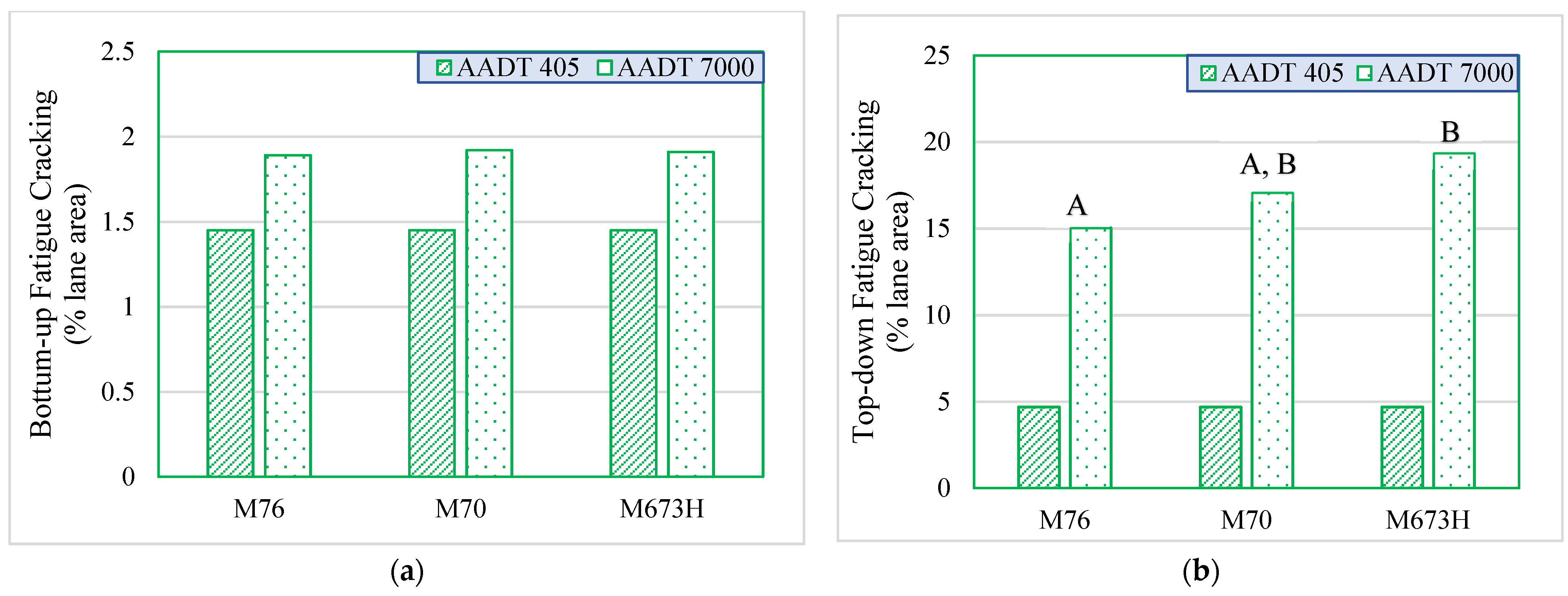
| Mixture Code | M76 | M70 | M673H | LaDOTD Specs [19] | |
|---|---|---|---|---|---|
| Binder Type | PG 76-22 | PG 70-22 | PG 67-22 | N/A | |
| Aggregate Blend | LS#78, % | 60.0 | 60.0 | 60.0 | |
| LS#11, % | 32.0 | 32.0 | 32.0 | ||
| CS, % | 8.0 | 8.0 | 8.0 | ||
| Asphalt Binder Content, % | 5.3 | 5.3 | 5.3 | ||
| HDPE dosage, % by weight of binder | 0.0 | 0.0 | 3.0 | ||
| Number of Gyrations in SGC | Ni | 7 | 7 | 7 | 7 |
| Nd | 65 | 65 | 65 | 65 | |
| Nf | 105 | 105 | 105 | 105 | |
| Design volumetric properties | %Gmm, Ni | 86.2 | 86.2 | 86.5 | <89 |
| %Gmm, Nf | 97.6 | 97.6 | 97.8 | <98 | |
| AV, % | 3.9 | 3.9 | 4.1 | 2.5–4.5% | |
| VMA, % | 14.8 | 14.8 | 15.6 | ≥13.5 | |
| VFA, % | 74.2 | 74.2 | 74.0 | 69–80 | |
| Passing, % | 25.0 mm | 100.0 | N/A | ||
| 19.0 mm | 100.0 | 100 | |||
| 12.5 mm | 96.3 | 90–100 | |||
| 9.5 mm | 86.2 | ≤89 | |||
| 4.75 mm | 43.0 | N/A | |||
| 2.36 mm | 31.3 | 29–58 | |||
| 1.18 mm | 22.5 | N/A | |||
| 0.600 mm | 16.3 | N/A | |||
| 0.300 mm | 9.2 | N/A | |||
| 0.150 mm | 5.2 | N/A | |||
| 0.075 mm | 4.0 | 4.0–10.0 | |||
| Test Designation | Testing Temperatures (°C) | No. of Replicates/Sample Dimension: Dia. (mm) × Height (mm) | Engineering Properties | Protocols/Standards |
|---|---|---|---|---|
| DM | 4.4, 25, 37.8, and 54 | 3/D100 × H150 | Stiffness | AASHTO T 342 [32] |
| LWT | 50 | 4/D150 × H60 | Rutting resistance | AASHTO T 324 [33] |
| MiST+LWT | 60 (MiST)/50 (LWT) | 4/D150 × H60 | Moisture Damage | ASTM D 7870; AASHTO T 324 [33,34] |
| SCB | 25 | 4/D150 × H57 | Intermediate Temperature Cracking resistance | ASTM D8044 [35] |
| Cantabro | 25 | 3/D150 × H115 | Durability | Tex-245-F [36] |
| IDT | 0, −10, and −20 | 3/D150 × H50 | Low-Temperature Cracking | AASHTTO T 322 [37] |
| Test | PG 76-22 | PG 70-22 | PG 67-22 + 3%HDPE |
|---|---|---|---|
| Rotational Viscometer (RV)—Original | |||
| RV (Pa·s, 135 °C) | 2.350 | 0.945 | 1.150 |
| Dynamic Shear Rheometer—Original | |||
| G*/sinδ (kPa, 70 °C) | - | 1.09 | 1.84 |
| G*/sinδ (kPa, 76 °C) | 1.64 | 0.65 | 0.97 |
| G*/sinδ (kPa, 82 °C) | 0.98 | - | - |
| Dynamic Shear Rheometer—RTFO | |||
| G*/sinδ (kPa, 70 °C) | - | 2.51 | 2.58 |
| G*/sinδ (kPa, 76 °C) | 2.55 | 1.37 | 1.24 |
| G*/sinδ (kPa, 82 °C) | 1.53 | - | - |
| Dynamic Shear Rheometer—PAV | |||
| G*·sinδ (kPa, 25 °C) | 3730 | 3895 | 4570 |
| G*·sinδ (kPa, 22 °C) | 5210 | 5690 | 6250 |
| Bending Beam Rheometer (BBR) PAV | |||
| S (MPa, −12 °C) | 173 | 157 | 164 |
| m-value (−12 °C) | 0.322 | 0.311 | 0.311 |
| S (MPa, −18 °C) | 357 | 311 | 407 |
| m-value (−18 °C) | 0.271 | 0.271 | 0.253 |
| ΔTc (°C) | -2.0 | -4.0 | -2.8 |
| Continuous Grading | PG 78-25 | PG 71-23 | PG 71-23 |
| The Binder Grade | PG 76-22 | PG 70-22 | PG 70-22 |
Disclaimer/Publisher’s Note: The statements, opinions and data contained in all publications are solely those of the individual author(s) and contributor(s) and not of MDPI and/or the editor(s). MDPI and/or the editor(s) disclaim responsibility for any injury to people or property resulting from any ideas, methods, instructions or products referred to in the content. |
© 2023 by the authors. Licensee MDPI, Basel, Switzerland. This article is an open access article distributed under the terms and conditions of the Creative Commons Attribution (CC BY) license (https://creativecommons.org/licenses/by/4.0/).
Share and Cite
Elnaml, I.; Liu, J.; Mohammad, L.N.; Wasiuddin, N.; Cooper, S.B., III; Cooper, S.B., Jr. Developing Sustainable Asphalt Mixtures Using High-Density Polyethylene Plastic Waste Material. Sustainability 2023, 15, 9897. https://doi.org/10.3390/su15139897
Elnaml I, Liu J, Mohammad LN, Wasiuddin N, Cooper SB III, Cooper SB Jr. Developing Sustainable Asphalt Mixtures Using High-Density Polyethylene Plastic Waste Material. Sustainability. 2023; 15(13):9897. https://doi.org/10.3390/su15139897
Chicago/Turabian StyleElnaml, Ibrahim, Jun Liu, Louay N. Mohammad, Nazimuddin Wasiuddin, Samuel B. Cooper, III, and Samuel B. Cooper, Jr. 2023. "Developing Sustainable Asphalt Mixtures Using High-Density Polyethylene Plastic Waste Material" Sustainability 15, no. 13: 9897. https://doi.org/10.3390/su15139897






